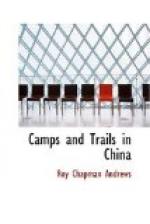Our specimens have brought out the fact that a remarkable individual variation exists in the color of the legs of these animals; this character was considered to be of diagnostic value, and probably is in some degree, but it is by no means as reliable as it was formerly supposed to be.
Two of the serows killed on the Snow Mountain have the lower legs rusty red, while in two others these parts are buff colored. The animals, all males of nearly the same age, were taken on the same mountain, and virtually at the same time. Their skulls exhibit no important differences and there is no reason to believe that they represent anything but an extreme individual variation.
The two specimens obtained by Mr. Caldwell at Yen-ping are even more surprising. The old female is coal black, but the young male is distinctly brownish-black with a chestnut stripe from the mane to the tail along the mid-dorsal line where the hairs of the back form a ridge. The horns of the female are nearly parallel for half their extent and approach each other at the tips; their surfaces are remarkably smooth. The horns of the young male diverge like a V from the skull and are very heavily ridged. The latter character is undoubtedly due to youth.
These serows are an excellent example of the necessity for collecting a large number of specimens from the same locality. Only by this means is it possible to learn how the species is affected by age, sex and individual variation and what are its really important characters. In the case of the gorals, our Expedition obtained at Hui-yao such a splendid series of all ages that we have an unequaled opportunity for intelligent study. Serows are entirely Asian and found in China, Japan, India, Sumatra and the Malay Peninsula.
On the Snow Mountain we found them living singly at altitudes of from 9,000 to 13,000 feet in dense spruce forests, among the cliffs. The animals seemed to be fond of sleeping under overhanging rocks, and we were constantly finding beds which gave evidence of very extensive use. Apparently serows seldom come out into the open, but feed on leaves and grass while in the thickest cover, so that it is almost impossible to kill them without the aid of dogs or beaters.
Sometimes a serow will lead the dogs for three or four miles, and eventually lose them or it may turn at bay and fight the pack after only a short chase; a large serow is almost certain to kill several of the hounds if in a favorable position with a rock wall at its back. The animal can use its strong curved horns with deadly effect for it is remarkably agile for a beast of its size.
In Fukien we hunted serows on the summit of a high mountain clothed with a dense jungle of dwarf bamboo. It was in quite different country from that which the animals inhabit in Yuen-nan for although the cover was exceedingly thick it was without such high cliffs and there were extensive grassy meadows. We did not see any serows in Fukien because of the ignorance of our beaters, although the trails were cut by fresh tracks. The natives said that in late September the animals could often be found in the forests of the lower mountain slopes when they came to browse upon the new grown mushrooms.




